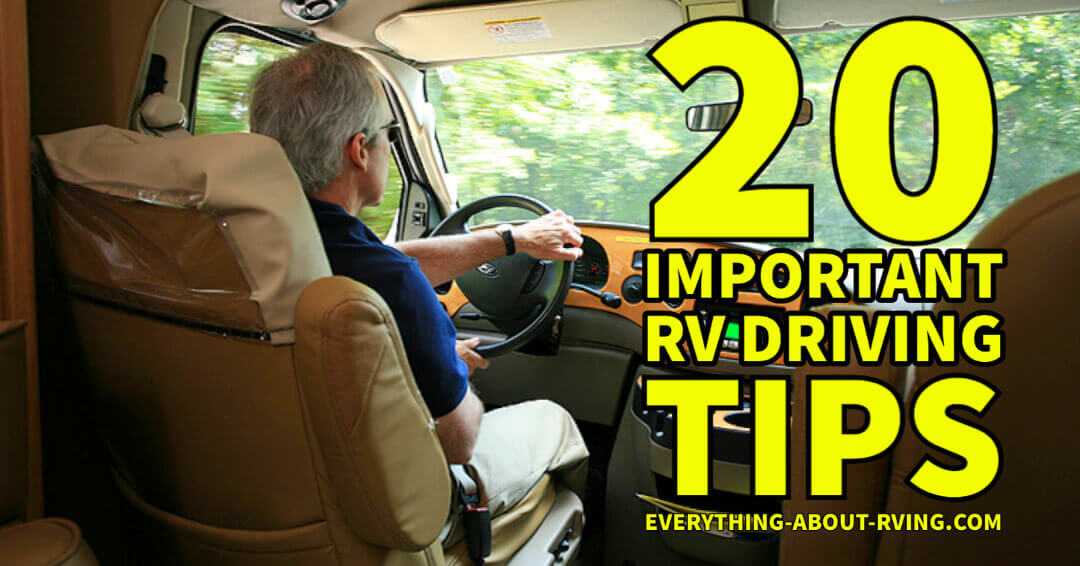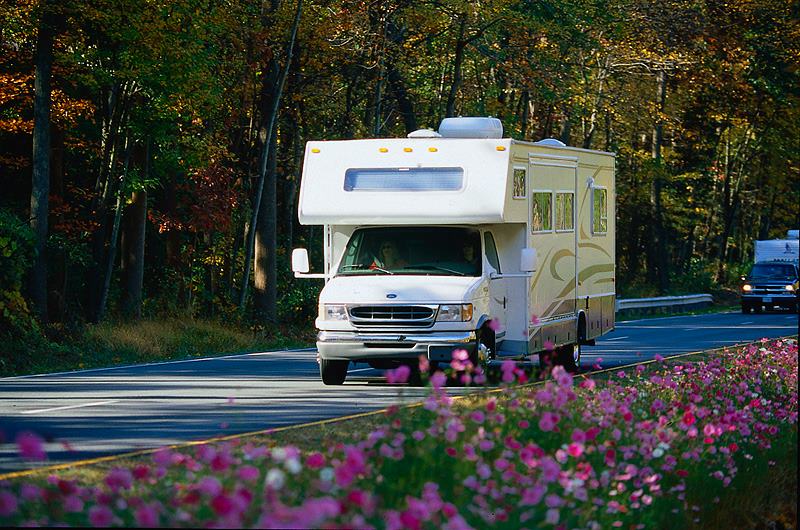- Home Page
- RVing Tips & Tricks
- Driving Tips
20 Important RV Driving Tips
There are times when driving an RV can be complicated and hazardous
By Jon Mills
Most RVs aren’t particularly difficult to drive these days, and is one of the reasons why they’re becoming more and more popular. However, the potential for something to go wrong remains a constant risk, and is much more difficult to rectify compared to a car once things start to spiral out of control.
The majority of drivers can adapt quite well to the increased size, height, and weight of an RV, but keeping alert, planning ahead, and driving cautiously remain top priority in the safe handling of your vehicle.
There are times when driving an RV or pulling a large trailer can be a complicated and hazardous, so to help you out we’ve put together a useful list of driving tips.
1. Back your RV In rather than Out, as you can more easily maneuver into a tight space going backwards (essentially the same as a vehicle with rear wheel steering). It’s also safer to pull out into traffic going forwards, and you can do it without having to rely on another person to guide you. If you have to back out, make sure you go round and take a good look for low branches, overhangs, or things poking out of the ground that could potentially cause damage.
2. If you’re on a tight road and your right wheels leave the asphalt, don’t be tempted to wrench the steering wheel in the opposite direction to correct it. Instead, slow down first and gradually steer back on to the road at a narrow angle.
3. If a line of traffic builds up behind you, move as far to the right as possible to allow those following to see the road ahead better for passing. If possible, pull over and let them pass.
4. When you have to pass another vehicle on a two lane road, drop back a bit first then accelerate towards it. If it’s clear, pull out and pass the vehicle when you reach it. This ensures you spend the least amount of time in the opposite lane, rather than pulling out and then accelerating.
5. Driving too fast is an obvious danger but stay as close to the speed limit as you can, and keep it as consistent as possible. Driving too slowly can pose its own dangers with impatient car drivers or get you a ticket from the police.
6. When
leaving a freeway, make sure you move into the far right lane about a
mile before your exit. Waiting until the last minute can make things
more rushed and more prone to error.
7. If travelling in the right lane of a freeway, temporarily move to the lane on your left when approaching an onramp to allow traffic to join the flow unhindered. This is especially applicable in cities where there are numerous on/off ramps coming up all the time.
8. If you see a vehicle parked at the side of the road, move over to the left as much as possible to allow for the possibility of them pulling out or a person suddenly opening the driver door.
9. Do not be tempted to cross the solid white traffic control line on the entrance to the freeway. Even if the entrance looks clear, there is a higher chance of a small vehicle or bike being missed resulting in a collision.
10. Don’t be afraid to use your horn to warn drivers ahead of you if you think there is a danger of a collision. And toot the horn a few times when backing up if you do not have a reverse warning beeper.
11. When turning; put one hand on the wheel at the 12 o’clock position and pull down, using the other hand to push up. This gives you a lot more control, and is much safer than one handed steering.
12. If you break down on or near the highway, use emergency flares as a warning to signal other drivers.
13. When driving on the freeway, do not position yourself in other people’s blind spots. When passing, do so as quickly as you can.
14. Learn the road signs, and what their different shapes and colors mean.
15. Learn to look way out in front, not just at the back of the vehicle in front of you. This way you will be far more prepared if you have to take action. Watch for multiple brake lights lighting up as a sign of impending danger.
16. Keep around a 5 second gap between you and the vehicle in front. The heavier the RV the more distance, and therefore time, you will need to stop.
17. Whenever you approach a changing situation on the road that may prove to be hazardous, cover you brakes (place your foot over the brake pedal without actually applying it) so that you can act very quickly in an emergency.
Save 50% Off of Campsites with Passport America
18. On the interstates, stay in the right hand lane as much as possible. The traffic is slower, you can see more of the road behind you with the driver’s side mirror, and it’s more convenient to pull over in an emergency.
19. On the Interstates and major highways watch out for debris (bits that have fallen off vehicles and blown out tires from trucks are common).
20. Always avoid driving in bad weather if possible. Heavy rain, fog, snow, or ice can dramatically increase the risk of an accident occurring.
Other Things to Consider
- Using your mirrors, signals, and lights.
- Always be alert to what’s happening behind you by regularly checking your mirrors. Adjust your side-view mirrors so that you can just about see the side of your vehicle to minimize the size of your blind spot (adjust convex or fish-eye
mirrors so that they include the blind spot). Remember; objects in the mirrors are closer than they appear. Also, be aware that there may be someone right behind you (tailgating) that could suddenly move out.
- Drive with your headlights on to make your RV more visible to other road users, and you should use you hazard lights whenever you are driving up a steep grade or stopped near moving traffic.
- Always use your turn signals, even if you think no one is around. Remember that pedestrians often look at a vehicle’s turn signals to decide whether or not to cross the road, and if you see something ahead that makes you think you’ll need to brake sharply, tap the brake pedal a few times to alert drivers behind you.
Copy the Professionals
Observe what Pro truckers do. They are the most experienced big vehicle drivers out there and you can learn a lot from them. Install a CB radio and listen to truckers’ chatter. You can glean a lot of important information about the road ahead, and if there’s an accident or construction work going on.
As with most things, practice will help you develop your skills, and in time you will become a good, safe, and confident RV driver. Before you set off, remember to plan your trip thoroughly, check your vehicle over properly, and get lots of rest. It goes without saying but you must always wear your seat belt whilst driving. You are vastly more likely to be killed or seriously injured (in even a minor accident) if you don’t. Always be vigilant, and keep safe.
Do you have any suggestions or comments on this topic? You can add them to this page by using the comments section located below.





